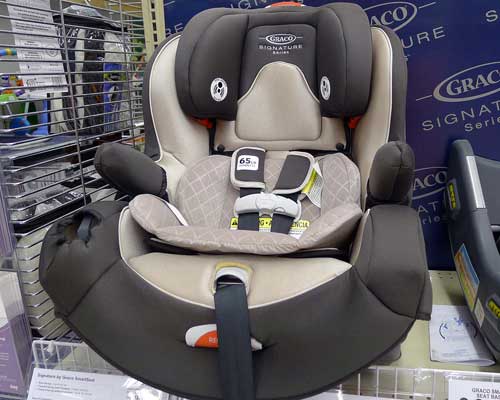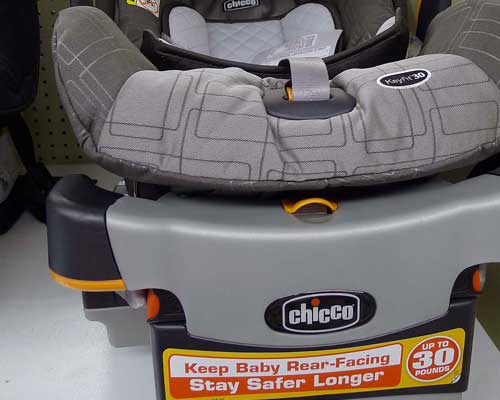The dangers of riding in a car for a baby boy or baby girl are real, and often under recognized. The time spent riding in a car for a child is usually many hours each week with all the trips to the doctors, grocery store, pharmacy, shopping, activities and visits to friends and family. Babies riding in a car are very vulnerable to impacts that can occur in an accident. The key to protecting your child in the car is to know and use the safety practices.
- Realize that automobile accidents are the leading cause of death for children.
- Car safety begins the moment you leave the house as thousands of children are injured or killed by vehicles backing up and driving in parking lots.
The first is to buy a safe car seat designed for a baby. Buying the right baby car seats or toddler car seat is an important decision as they often vary in the amount of protection they provide, size, comfort and style. Make sure you fasten your child in correctly into the appropriate car seat for his or her size and age. Using the wrong car seat or not properly securing the baby can make it so your child is not properly protected in the event of a car collision.
The second thing to know about is the dangers of air bags for infants, toddlers, and young children. Never put a rear facing car seat in the front-passenger seat in a motor vehicle that air bags. The force of a deployed air bag is so powerful that serious injury or death can result to young children. Especially dangerous are rear facing child safety seats when put in the front passenger seat, as the child is jolted forward during the collision and then immediately jolted back after being hit by the air bag, which can break a child’s neck. Putting a car seat in the front seat of a vehicle with a passenger air bag is in many states against the law. The back seats are the safest for young children away from the front seat dashboard since when an air bag deploys its impact can be extremely powerful and dusty making it hard to breath.
Defensive driving is the best way to drive safely so do not speed and be extra careful at intersections and in heavy traffic by staying back a safe distance. Surprisingly, many accidents happen while driving in parking lots since people tend to put their guard down a little while driving around looking for a parking spot. Also, statistics have shown that most accidents happen within 1 mile of your home, so always properly secure your child in a car seat no matter how short the distance you are traveling.
Motor vehicles can quickly heat up in the sun to extreme temperatures and air conditioning left on while parked can cause tragic situations. Never under any circumstance leave a child unattended in a motor vehicle not even for a minute. Recognize that not only is it incredibly unsafe for a child to be left alone but it is also against the law to leave a child unattended in a parked vehicle. Be aware that you can help save a life of a child by quickly calling the local police if you ever see a child left unattended in a motor vehicle especially when it is hot out as time is often of the essence as the hotter air makes breathing more difficult, dehydration and the potential for the child to get burned by the plastic and metal parts of the car seat. In fact heat exhaustion can set in pretty quick for a child locked in a hot car causing the child to overheat. As the temperature in the car rise the child sweats until he or she becomes dehydrated from all the water loss and eventually die of dehydration. Even in mild weather a child could suffer hypothermia, and in cold weather hypothermia can set in very quickly as the child’s body temperature drops. In an emergency first contact emergency medical service (911). Knowing the whereabouts of your child at all times is a crucial aspect of parenting and leaving your child alone in a car also opens up the possibility of strangers approaching your child. If your significant other, spouse, nanny, family or friend drives the child to daycare, a restaurant, school, gymnastics class or wherever make sure that person calls you when they arrive at the destination and keeps you informed of the whereabouts of your child.
Guidelines for keeping infants and toddlers safe around motor vehicles include when to take your baby out of the car and when to put the baby in the car. Often, you will have stuff in your hands like diaper bags, a stroller, purse, toys and more. So after shopping trips, the question is are you supposed to put the baby in the car first and then put the groceries and stuff in the car or is it vice versa, load the groceries first and then put the baby in the motor vehicle? Safest is probably to put the baby in first and then the groceries. If you use a shopping cart, try and park next to a shopping cart return. The reason it is best to put the baby in the car first is in case someone who is not paying attention drives by and hits the shopping cart, it is better if it is full of groceries and not the baby. Also, a shopping cart could roll away and that would be incredibly dangerous in a parking lot if it had a baby in it.


